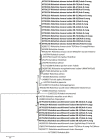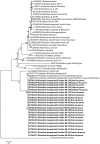Identification of tick-borne pathogens in ticks feeding on humans in Turkey
- PMID: 25101999
- PMCID: PMC4125308
- DOI: 10.1371/journal.pntd.0003067
Identification of tick-borne pathogens in ticks feeding on humans in Turkey
Abstract
Background: The importance of tick-borne diseases is increasing all over the world, including Turkey. The tick-borne disease outbreaks reported in recent years and the abundance of tick species and the existence of suitable habitats increase the importance of studies related to the epidemiology of ticks and tick-borne pathogens in Turkey. The aim of this study was to investigate the presence of and to determine the infection rates of some tick-borne pathogens, including Babesia spp., Borrelia burgdorferi sensu lato and spotted fever group rickettsiae in the ticks removed from humans in different parts of Ankara.
Methodology/principal findings: A total of 169 ticks belonging to the genus Haemaphysalis, Hyalomma, Ixodes and Rhipicephalus were collected by removing from humans in different parts of Ankara. Ticks were molecularly screened for Babesia spp., Borrelia burgdorferi sensu lato and spotted fever group rickettsiae by PCR and sequencing analysis. We detected 4 Babesia spp.; B. crassa, B. major, B. occultans and B. rossi, one Borrelia spp.; B. burgdorferi sensu stricto and 3 spotted fever group rickettsiae; R. aeschlimannii, R. slovaca and R. hoogstraalii in the tick specimens analyzed. This is the report showing the presence of B. rossi in a region that is out of Africa and in the host species Ha. parva. In addition, B. crassa, for which limited information is available on its distribution and vector species, and B. occultans, for which no conclusive information is available on its presence in Turkey, were identified in Ha. parva and H. marginatum, respectively. Two human pathogenic rickettsia species (R. aeschlimannii and R. slovaca) were detected with a high prevalence in ticks. Additionally, B. burgdorferi sensu stricto was detected in unusual tick species (H. marginatum, H. excavatum, Hyalomma spp. (nymph) and Ha. parva).
Conclusions/significance: This study investigates both the distribution of several tick-borne pathogens affecting humans and animals, and the presence of new tick-borne pathogens in Turkey. More epidemiological studies are warranted for B. rossi, which is very pathogenic for dogs, because the presented results suggest that B. rossi might have a wide distribution in Turkey. Furthermore, we recommend that tick-borne pathogens, especially R. aeschlimannii, R. slovaca, and B. burgdorferi sensu stricto, should be taken into consideration in patients who had a tick bite in Turkey.
Conflict of interest statement
The authors have declared that no competing interests exist.
Figures





References
-
- Sonenshine DE (1991) Biology of ticks. Vol. 1. Oxford: Oxford University Press. 447 p.
-
- Estrada-Pena A, Jongejan F (1999) Ticks feeding on humans: a review of records on human-biting Ixodoidea with special reference to pathogen transmission. Exp Appl Acarol 23: 685–715. - PubMed
-
- Sparagano OAE, Allsopp MTEP, Mank RA, Rijpkema SGT, Figueroa JV, et al. (1999) Molecular detection of pathogen DNA in ticks (Acari: Ixodidae): A review. Exp Appl Acarol 23: 929–960. - PubMed
MeSH terms
LinkOut - more resources
Full Text Sources
Other Literature Sources
Medical
Molecular Biology Databases
Miscellaneous

